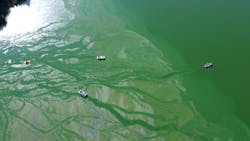About the author:
Jordan Lind is CEO for Clearas Water Recovery. Lind can be reached at [email protected].
70% of U.S. rivers, lakes, reservoirs and estuaries do not meet minimum U.S. EPA water quality standards. A leading cause of this impairment is excess nutrients, such as nitrogen and phosphorus, due to agricultural runoff and industrial and municipal wastewater discharge. As an integral part of improving biodiversity, wastewater facilities have been regulated to play a major role in reducing these pollutants from entering waterways.
Historically, wastewater design has been a linear, treatment-based approach demanding high energy and chemical consumption while generating substantial and costly waste residuals. The old adage was, “We collect it, we treat it and we dispose of it.”
The Opportunity to Transition from Treatment to Recovery
Through the development of solutions and technology, the opportunity to transition away from linear-based treatment and toward sustainable resource recovery is now available. Wastewater treatment facilities can solve the nutrient problem while alleviating current environmental, social and economic pressures.
One such solution is Advanced Biological Nutrient Recovery (ABNR), invented by Clearas Water Recovery. ABNR turns the problem (algae blooms) into the solution (nutrient recovery). It bolts onto existing wastewater infrastructure and is a demonstration in biomimicry—a term indicating how the company looked to nature to solve the industrial design challenge of excess nutrients in a sustainable way. In July 2020, the village of Roberts, Wisconsin, became the first, full-scale installation of ABNR. Three additional ABNR resource recovery plants are in final design and will begin construction in early 2021.
Using Microalgae as Bio-filters
The village of Roberts, like many other wastewater treatment plants, is required to achieve low nutrient levels in its discharge. For example, phosphorus must be removed to nearly non-detect levels. In side-by-side trials, ABNR consistently outperformed chemical alternatives to meet low level phosphorus (<0.075 mg/L) and ammonia (<1.0 mg/L) requirements. Just as important, this solution enabled the village to transition its wastewater treatment plant to a resource recovery facility with a life cycle cost advantage over traditional treatment methods.
The solution uses microalgae to act as bio-filters and to recover phosphorus and nitrogen as well as capture carbon dioxide in an optimized and easily controlled environment. The algae, which leverage sunlight, grow aggressively within a vertical array of photobioreactors and are constantly harvested (wasted) to maintain a balance between the amount of food (nutrients) and mass (algae) in the system. Following the separation from clean reusable water, the excess algae (plant-based material) then becomes a valuable biomaterial that provides a recurring income stream to the municipality.
Once harvested, this biomaterial is further processed based on buyer specifications. Clearas markets, sells and distributes the biomaterial into diversified markets with growing demand. Applications include bioplastics and foams, cosmetics, protein feed and food supplements, soil amendment and specialty chemicals. In the case for the village of Roberts, the biomaterial is dried and sold to a strategic partner, Algix, which converts the algae into a thermoplastic for use in shoe soles. Example customers include Adidas, Billabong, Dr. Scholls, Merrell and Volcom.
Enabling a Circular Design
While the main function of ABNR is directed towards nutrient recovery, the solution also advances resource recovery and optimizes the entire wastewater facility’s life cycle and upstream plant operations. Examples of these benefits include:
- Reduced Energy Use: Algae prefer ammonia, and decreasing the energy used in nitrification provides significant opportunity for savings.
- Eliminate or Lower Chemical Use: Decrease or eliminate the use of metal salts for phosphorus reduction and reduce sludge generation, storage and hauling.
- Decrease Greenhouse Gas Emissions: Leverage algae’s necessity for a carbon source by capturing waste carbon dioxide from gas boilers or combined heat and power engines. The reduction of nitrification significantly reduces nitrous dioxide emissions, which is a large direct contributor to a wastewater treatment facility’s greenhouse gas emissions.
- Leverages Natural Processes: Algae require water, phosphorus, nitrogen and carbon to flourish. Wastewater treatment is focused on the removal, reduction and recovery of these same elements.
- Sustainable Feedstock: Excess growth of the algae results in a plant-based biomaterial, which has strong potential in diversified markets.
This technology can provide sustainable, high quality nutrient recovery that is modular and scalable, enabling a path toward resource recovery for more sustainable future.

